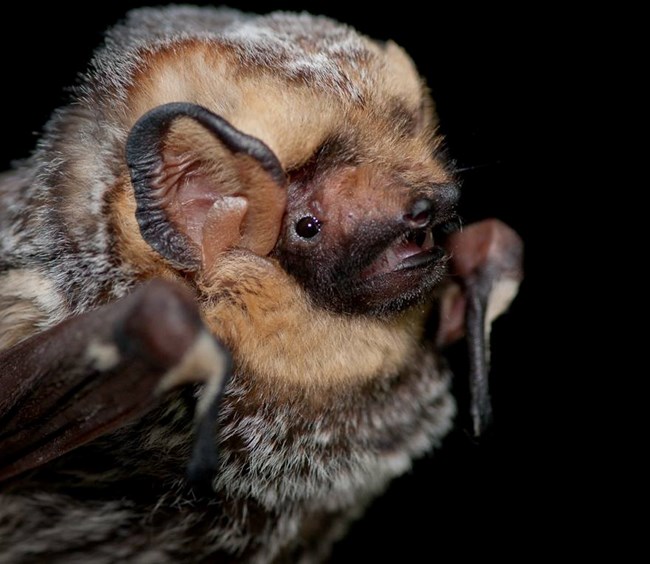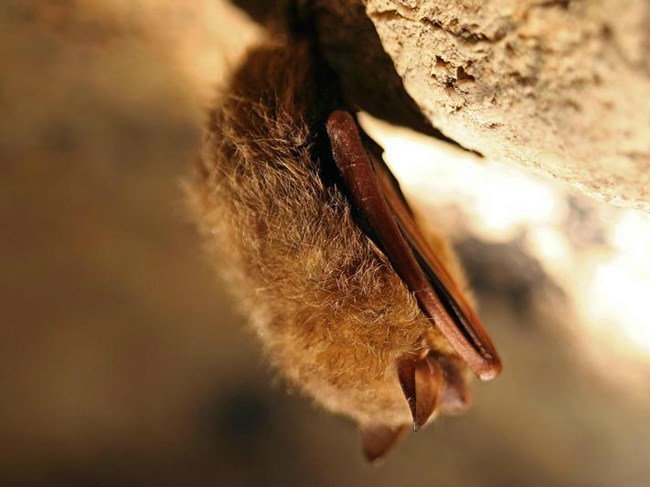Part of a series of articles titled Wildlife in the Badlands.
Previous: Badlands Birds
Article

NPS/Isle Royale National Park
Badlands National Park is a 244,000-acre park in southwestern South Dakota that conserves the rugged badlands topography, rich fossil beds, and a large expanse of mixed-grass prairie. Surface water is scarce at the park, but there is bat foraging and drinking habitat at Sage Creek, a sediment-laden drainage, as well as at multiple bison stock ponds. The highly eroded badlands provide crevices that are used as roosting habitat for bats. The unique physiographic environment of the park supports a bat community very different from other parks in the Northern Great Plains Network.
The Northern Great Plains Inventory & Monitoring Network monitors bats to detect long-term trends and to get early warning of undesirable changes in bat populations at the park. A fungal disease called white-nose syndrome is spreading quickly, threatening bat populations in North America. First documented in a New York cave in 2006, this disease is associated with more than seven million bat deaths. It spreads primarily from bat to bat and humans might be spreading the disease by carrying nearly invisible fungal spores on their shoes and clothing from one cave to another. Bat monitoring helps us understand changes occurring with the spread of this devastating disease.
Twelve stationary recording stations and six mobile recording routes were established in 2014 in three areas of Badlands National Park for long-term bat monitoring: Sage Creek Road, Conata Basin, and Cedar Pass areas. Acoustic recorders detect the unique ultrasonic calls bats use for echolocation. There were 293,639 bat call recordings from stations across all survey nights from 2014 to 2017. The data were analyzed through specialized software programs that make preliminary identifications of the bat species based on individual call characteristics, such as frequency and shape. Some bat species make calls that are similar to other species, which is why researchers with special expertise review the calls and make the final species determinations.

NPS
| Common Name | Scientific Name | 2014–2017 Status |
|---|---|---|
| Big brown bat | Eptesicus fuscus | Present |
| Eastern red bat | Lasiurus borealis | Present |
| Hoary bat | Lasiurus cinereus | Present |
| Silver-haired bat | Lasionycteris noctivagans | Present |
| Western small-footed myotis | Myotis ciliolabrum | Present |
| Little brown bat | Myotis lucifugus | Present |
| Fringed myotis | Myotis thysanodes | Present |
| Long-legged myotis | Myotis volans | Present |
| Tri-colored bat | Perimyotis subflavus | Present |

NPS/Cumberland Gap National Historic Park
In 2017, the fungus (Pseudogymnoascus destructans) that causes white-nose syndrome was detected for the first time in South Dakota at Badlands National Park. It was detected on one western small-footed bat and four big brown bats. This is the first time the fungus has been detected on a western small-footed bat. See a map of white-nose syndrome in national parks and learn more about how you can help prevent the spread of this fungus. Continued monitoring, and park staff and visitor observations, will help us protect the bat communities that live and forage in the park.
Dan Licht, Midwest Region Wildlife Biologist
Protocol Contact: Northern Great Plains Network
Summary by Tani Hubbard, updated in 2019
Part of a series of articles titled Wildlife in the Badlands.
Previous: Badlands Birds
Last updated: July 28, 2020